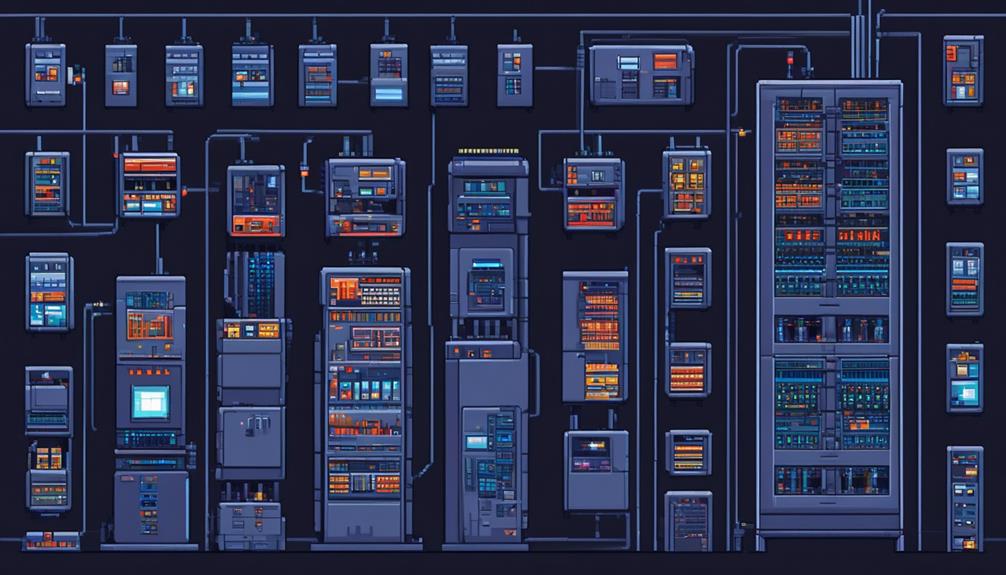Telecom power systems play a crucial role in ensuring uninterrupted and reliable communication for the telecommunications industry. As technology continues to advance, the demand for efficient power management solutions becomes increasingly important.
In this discussion, we will explore the various types of power solutions available for telecommunications, including backup options and fault-managed power systems.
We will also delve into the advantages of higher voltages and the intelligent features found in modern telecom power systems.
Additionally, we will discuss the transition to hybrid cables and the benefits of monitoring and control in telecom power systems.
Finally, we will touch upon the concept of future-proofing telecom infrastructure with smart power solutions.
Join us as we explore the intricacies of telecom power systems and their significance in the ever-evolving world of telecommunications.
Key Takeaways
- Telecom power systems are crucial for maintaining uninterrupted communication in the telecom industry.
- These systems provide reliable and efficient power management solutions, ensuring the integrity and stability of the entire telecom infrastructure.
- Backup options such as battery backup solutions and generator power supply are essential for maintaining operational continuity during outages.
- Higher voltages in telecom power systems offer benefits such as improved power efficiency, cost reduction, enhanced safety measures, future-readiness, and improved system performance.
Importance of Telecom Power Systems

Telecom power systems play a vital role in ensuring uninterrupted communication in the telecom industry, making them of utmost importance. These systems are designed to provide reliable and efficient power management solutions, ensuring that telecommunication networks remain operational even during power outages or fluctuations.
The importance of telecom power systems lies in their ability to maintain the integrity and stability of the entire telecom infrastructure. Without a robust power system, telecommunication networks would be vulnerable to disruptions, leading to dropped calls, loss of data, and overall degraded performance.
One key aspect of telecom power systems is their focus on reducing environmental impact and promoting clean energy solutions. With the increasing importance of sustainability, telecom power solutions are designed to integrate renewable energy sources, such as solar and wind, along with traditional power sources. This approach not only ensures continuous power supply but also helps reduce carbon emissions and dependence on non-renewable energy.
Delta Electronics, Inc. is a trusted provider of telecom power systems, known for their innovation and industry advancements. Their solutions encompass a wide range of applications, including mobile base stations, central offices, broadband, and remote power. By integrating renewable and traditional sources, these power systems maximize energy utilization and reduce the cost of ownership for telecom operators.
Moreover, fault-managed power systems, such as the Cence HV, are crucial for telecom power applications. These systems provide intelligent and safe power distribution, efficient power utilization, and compatibility with hybrid fiber cables. They ensure that power is delivered precisely where it is needed, minimizing wastage and optimizing network performance.
Types of Power Solutions for Telecommunications
What are the various types of power solutions available for telecommunications?
Telecom power systems play a crucial role in ensuring uninterrupted communication by providing efficient power management and reliable systems. These power solutions are designed to cater to diverse applications such as mobile base stations, central offices, broadband, and remote power.
One type of power solution for telecommunications is the Chameleon family. These high-performance and reliable power solutions are specifically designed for small cells. They promote a neutral exterior that blends into the environment, ensuring a seamless integration with the surroundings. Additionally, the Chameleon family offers plug-and-play installation, making it easy to deploy and maintain.
Another type of power solution is fault-managed power systems, such as Cence HV. These systems provide higher voltages, efficient power distribution, and intelligent controls. They are also compatible with hybrid fiber cables, making them a future-ready power solution. Fault management capabilities allow for quick identification and resolution of power-related issues, ensuring uninterrupted communication.
Power systems are essential for the functioning of communication networks. While international standards for complete power systems in communication services are still under development, they are often defined by individual companies or national administrations. These standards ensure that power solutions meet specific requirements and provide a reliable power supply.
Backup Options for Telecom Power Systems

When it comes to backup options for telecom power systems, two common solutions are battery backup and generator power supply.
Battery backup solutions provide a reliable source of power during short-term outages, ensuring uninterrupted communication.
On the other hand, generator power supply offers a longer-lasting backup option, capable of providing continuous power for extended periods, particularly during prolonged outages or in areas with unreliable grid connections.
Both options play a crucial role in maintaining the operational continuity of telecom power systems.
Battery Backup Solutions
Battery backup solutions are essential for ensuring uninterrupted power supply in telecom power systems. Delta Electronics, Inc. offers a range of power solutions for telecom applications, including battery backup options. These solutions are designed to provide backup power in the event of a power outage or failure, ensuring continuous operation of telecom equipment.
Delta Electronics, Inc. focuses on innovative and fault-managed power systems that provide efficient power distribution and compatibility with hybrid fiber cables. These battery backup solutions not only ensure uninterrupted power supply but also reduce costs and improve power management in telecom power systems.
Generator Power Supply
Generator power supply is a reliable backup option for telecom power systems, ensuring uninterrupted communication during mains power failure. Telecom power systems are designed to maximize energy utilization and reduce the cost of ownership. Fault-managed power systems, such as Cence HV, provide higher voltages and offer suitable protection from electrical hazards, prioritizing the safety of telecom technicians. Efficient power distribution in telecom power systems allows for a reduction in cable gauge size and associated capital costs. Additionally, intelligent controls add another layer of intelligence to the power system. Cummins, a global leader in power solutions for the telecom industry, offers pre-integrated power systems and remote monitoring services. These solutions are used by telecom companies around the world to ensure reliable and efficient power supply for their communication networks.
| Telecom Power Systems |
|---|
| Backup Option |
| Fault-Managed Power |
| Efficient Distribution |
| Intelligent Controls |
| Cummins Power Solutions |
Advantages of Fault-Managed Power Systems
Fault-managed power systems offer a multitude of advantages that make them superior to traditional 48V DC systems for telecom power.
One of the key advantages of fault-managed power systems is their ability to provide higher voltages. While 48V DC systems have been widely used in the telecom industry for backup power, fault-managed power systems can supply voltages up to 450V DC, allowing for greater flexibility and scalability in power distribution.
In addition to higher voltages, fault-managed power systems also offer improved power reliability. The National Electrical Code (NEC) has standardized fault-managed power systems in its 2023 edition, ensuring safe distribution of up to 450V DC. This standardization provides the telecom industry with a reliable and consistent framework for implementing fault-managed power systems, enhancing overall power system reliability.
Another advantage of fault-managed power systems is their energy efficiency. By employing fault-management techniques, these systems are able to detect and respond to faults in the power system, minimizing the risk of electrical hazards. This means that mechanical protection or breakers are not required, resulting in a more streamlined and energy-efficient solution.
One notable example of a fault-managed power system is Cence HV. This system not only provides high voltage capabilities but also offers suitable protection from fire and shock hazards. Furthermore, Cence HV is designed to shut off power over 1000 times faster than other fault-managed power systems if a fault is detected, ensuring rapid response and minimizing downtime.
Benefits of Higher Voltages in Telecom Power Systems

Higher voltages in telecom power systems offer numerous benefits, including more efficient power distribution and reduced capital costs associated with cabling and copper.
Here are the key advantages of higher voltages in telecom power systems:
- Power Efficiency: With higher voltages, power can be distributed more efficiently over thinner cables. This reduces voltage drop and allows for the transmission of power over longer distances without significant loss. By minimizing energy losses, higher voltages contribute to improved power efficiency in telecom networks.
- Cost Reduction: The use of higher voltages in telecom power systems leads to significant cost savings. Thinner cables can be used to carry the same amount of power, resulting in reduced capital costs associated with cabling and copper. This cost optimization is particularly beneficial in large-scale telecom deployments.
- Safety Measures: Fault-managed power systems that can supply higher voltages, such as up to 450V DC, offer enhanced safety measures compared to traditional 48V DC systems. These systems ensure efficient power transmission while prioritizing safety. With proper fault management, the risk of electrical accidents and system failures can be minimized.
- Future-Readiness: Telecom power systems utilizing higher voltages are future-ready. They are compatible with hybrid fiber cables, enabling efficient power distribution for both fault-managed power and 5G networks. This adaptability ensures that the power systems can meet the evolving needs of telecom networks and support the deployment of advanced technologies.
Intelligent Features in Modern Telecom Power Systems
Intelligent features in modern telecom power systems offer advanced energy management capabilities, ensuring efficient power utilization and reduced cost of ownership.
These systems also incorporate enhanced fault detection mechanisms, continuously monitoring cables for faults and enabling prompt troubleshooting and maintenance.
Additionally, intelligent battery monitoring functionality allows for real-time monitoring of battery health and performance, ensuring reliable backup power during outages.
Advanced Energy Management
Advanced Energy Management in modern telecom power systems incorporates intelligent features to optimize power utilization and reduce costs. These advanced energy management systems employ various strategies and techniques to achieve advanced energy efficiency and cost reduction. Here are some key features:
- Fault-managed power systems: These systems can supply higher voltages, reducing cabling and capital costs.
- Plug-and-play installation and maintenance: This feature enhances safety and minimizes downtime by allowing easy and hassle-free setup and maintenance.
- Compatibility with hybrid fiber cables: This enables future-ready power distribution for fault-managed power and 5G networks.
- Integration of smart controls and digital twin software: These innovative technologies ensure an intelligent and safe power system, enabling better monitoring and control.
Enhanced Fault Detection
Enhanced fault detection is a crucial aspect of modern telecom power systems, ensuring uninterrupted communication by proactively identifying and addressing potential faults.
The importance of fault detection cannot be overstated, as even minor disruptions in power supply can lead to significant downtime and loss of revenue for telecom operators.
By integrating intelligent features, such as advanced analytics and real-time monitoring, telecom power systems can efficiently detect faults and take immediate corrective actions, minimizing the impact on communication services.
These systems leverage cutting-edge technologies to continuously monitor parameters like voltage, current, and temperature, allowing for early detection of potential issues before they escalate.
This integration of fault detection not only enhances the reliability and efficiency of telecom power systems but also contributes to the overall sustainability of the industry by reducing environmental impact and promoting clean energy solutions.
Intelligent Battery Monitoring
With the integration of intelligent features, modern telecom power systems are able to effectively monitor and manage battery health and performance in real-time, ensuring proactive maintenance and optimizing energy usage. This is made possible through the implementation of intelligent battery monitoring systems that offer several benefits:
- Predictive maintenance: By constantly monitoring battery behavior and performance, these systems can identify potential issues and initiate proactive replacement of batteries before failure. This helps to avoid downtime and ensures uninterrupted power supply.
- Optimization of charging: Advanced analytics and reporting capabilities provide insights into battery charging patterns, enabling telecom operators to optimize charging cycles. This not only maximizes battery lifespan but also reduces energy consumption and costs.
- Energy usage optimization: Intelligent battery monitoring systems enable telecom power systems to optimize energy usage by efficiently managing battery charging and discharging cycles. This helps to minimize energy wastage and ensures optimal utilization of available power resources.
- Integration with overall power management systems: These monitoring systems seamlessly integrate with other power components in the telecom network, enabling coordinated operations and efficient utilization of battery power.
Transitioning to Hybrid Cables With Fault-Managed Power Systems
Transitioning to hybrid cables with fault-managed power systems is a crucial step in optimizing telecom power infrastructure. Fault-managed power systems are of utmost importance as they are capable of supplying higher voltages, reaching up to 450V DC. This makes them superior to traditional 48V DC systems for telecom power. By implementing a fault-managed DC power system, such as the Cence HV, the transition to hybrid cables can be streamlined effectively.
Hybrid fiber cables are a significant advancement in telecom power systems as they combine the benefits of optical fibers for data transmission and copper wires for power transmission. This integration allows for a single cable to carry both power and data, reducing the need for separate infrastructure. By incorporating hybrid cables into the telecom power system, efficiency and flexibility are enhanced, leading to cost savings.
One of the advantages of fault-managed power systems is the ability to operate at higher voltages. Higher voltages in telecom power systems offer several benefits. Firstly, they enable longer cable runs without significant power loss, reducing the need for additional power sources. Secondly, higher voltages allow for smaller conductor sizes, resulting in reduced cable weight and lower installation costs. Lastly, higher voltages enable more efficient power conversion and distribution, leading to improved overall system performance.
Cence HV is a fault-managed power system that is compatible with hybrid fiber cables, making it a future-ready power solution for telecom infrastructure. It provides higher voltages, up to 450V DC, while still adhering to low-voltage wiring practices. This allows for a seamless transition to hybrid cables without compromising safety or reliability.
Monitoring and Control in Telecom Power Systems

Monitoring and control play a critical role in ensuring efficient power management and uninterrupted communication in telecom power systems. Delta Electronics, Inc. offers reliable and high-quality power solutions that maximize energy utilization. These power systems are designed to cater to various applications, including mobile base stations, central offices, broadband, and remote power, and they integrate both renewable and traditional sources. With the increasing focus on sustainability, the integration of renewable energy sources is crucial for telecom power systems.
Remote monitoring enables operators to monitor and manage power systems from a centralized location, ensuring optimal performance and quick response to any issues.
To provide power efficiency, fault-managed power systems like Cence HV are utilized. These systems offer superior protection and safety by swiftly shutting off power in case of a fault. This not only prevents damage to the telecom infrastructure but also protects personnel working on the equipment. Additionally, intelligent power systems like Cence HV enable efficient power distribution, reducing costs and ensuring compatibility with hybrid fiber cables.
Remote monitoring allows operators to monitor power consumption, battery status, and other performance metrics in real-time. This enables proactive maintenance and troubleshooting, minimizing downtime and optimizing energy utilization. By remotely monitoring and controlling telecom power systems, operators can identify potential issues and take preventive measures before they escalate, ensuring uninterrupted communication services.
Future-Proofing Telecom Infrastructure With Smart Power Solutions
Future-proofing telecom infrastructure can be achieved by implementing smart power solutions that ensure uninterrupted communication and efficient power management. Delta Electronics, Inc. offers reliable and high-quality telecom power systems designed for maximum energy utilization, reduced cost of ownership, and a lighter environmental footprint. These power solutions integrate renewable and traditional sources, offering AC and DC compatibility, and feed and load input and output options. They are suitable for applications such as mobile base stations, central offices, broadband, remote power, and CORD implementation, providing efficient power distribution and reduced costs.
To further enhance future-proofing capabilities, smart grid integration is crucial. By integrating telecom infrastructure with the smart grid, power systems can dynamically respond to changes in the grid and optimize energy consumption. This ensures that telecom networks can operate efficiently while minimizing their impact on the grid.
In addition to smart grid integration, energy efficiency measures play a vital role in future-proofing telecom infrastructure. Power solutions with advanced energy management features can optimize power usage, reduce energy waste, and lower operational costs. These measures not only benefit the telecom industry but also contribute to a greener and more sustainable environment.
Remote monitoring capabilities are another key aspect of future-proofing telecom infrastructure. Power systems equipped with remote monitoring allow for real-time monitoring, diagnostics, and proactive maintenance. This enables telecom operators to identify and address issues promptly, minimizing downtime and ensuring uninterrupted communication services.
To summarize, implementing smart power solutions in telecom infrastructure is essential for future-proofing. By integrating with the smart grid, adopting energy efficiency measures, and incorporating remote monitoring capabilities, telecom networks can achieve uninterrupted communication, efficient power management, and contribute to a more sustainable future.
| Benefits of Smart Power Solutions |
|---|
| Reliable and uninterrupted communication |
| Efficient power management |
| Maximum energy utilization |
| Reduced cost of ownership |
| Lighter environmental footprint |
Frequently Asked Questions
What Is Telecom Power System?
Telecom power systems are crucial for ensuring uninterrupted communication in the telecom industry. They provide backup power solutions to maintain network functioning during power outages.
Batteries play a significant role in telecom power systems, storing energy and supplying it when needed.
Energy efficiency is a key consideration in these systems, as they aim to optimize power usage and reduce costs.
What Is Power Supply in Telecom?
A power supply in the telecom industry refers to the source of electrical energy that powers various equipment and devices used for communication purposes. It is essential for telecom systems to have reliable power sources to ensure uninterrupted operation.
Backup options such as batteries or generators are often implemented to provide a backup power supply in case of power outages. Power consumption is a critical consideration in telecom power systems to optimize energy usage and reduce operational costs.
Why 48v Is Used in Telecom?
The use of 48V in telecom has several advantages.
Firstly, it allows for standardized power distribution and interoperability across different telecom equipment.
Secondly, 48V systems provide a balance between energy efficiency, safety, and cost-effectiveness for telecom applications.
Additionally, the voltage level of 48V is well-suited for telecom equipment, ensuring optimal performance and reliability.
Moreover, 48V systems are widely adopted in telecom due to their compatibility with various power sources and ease of integration in telecom infrastructure.
The importance of power backup in telecom further underscores the efficiency of 48V power systems.
What Is Telecom Smps?
A telecom SMPS, or Switched Mode Power Supply, is a power system designed for efficient power management in telecom applications.
It is responsible for converting electrical energy from the main power source into the appropriate voltage levels required by telecom equipment.
Telecom SMPS ensures power efficiency and voltage regulation, allowing for reliable and uninterrupted communication in telecom networks.
